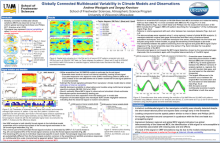Globally connected multidecadal variability in climate models and observations
Andrew
Westgate
University of Wisconsin - Milwaukee
Poster
An intriguing property of climate variations recorded in the Earth’s sea-surface and atmospheric near-surface temperatures is the existence, on top of a non-uniform global warming trend, of multidecadal variability exhibiting globally coherent patterns. Identifying such internal patterns requires one to combine modern reanalyses of atmospheric observations with the estimates of the climate response to variable natural and anthropogenic forcings based on ensemble simulations of the 20th-century climate by state-of-the-art global coupled climate models. Comparing this dominant internal signal in the reanalyses and climate-model simulations is a useful way to gain insights as to the dynamical origin of such modes, as well as the processes that underlie any differences between the observed and simulated signals.
Here we adopt and combine the previous, as well as newly developed statistical methodologies to provide updated estimates of such global multidecadal teleconnections in the up-to-date reanalysis data sets, including the NOAA/CIRES/DOE 20th-Century Reanalysis version 3 and ECMWF Reanalysis of the 20th Century, and the ensemble simulations of the 20th-century climate by the models participating in the Coupled Model Intercomparison Project, phase 5 and 6, alongside a new comprehensive analysis of the associated uncertainties.
We find that the global multidecadal signal in the reanalysis data sets is consistent across different reanalysis products and different methods of subtracting the forced signal to isolate the internal variability. Furthermore, essentially the same signal is identified in the global or hemispheric analyses of the near-surface air temperatures over ocean, land, or the combined region, underscoring its global nature. This signal is also not particularly susceptible to scarce data coverage in the early climate record due exactly to its global teleconnectedness, or to the end effects owing to the fact that the most pronounced variations associated with this signal occur away from the ends of the record. On the other hand, the analogous signal detected in most of the climate models is substantially weaker, tends to have shorter time scales, and exhibits different spatial patterns than the observed variability.
Here we adopt and combine the previous, as well as newly developed statistical methodologies to provide updated estimates of such global multidecadal teleconnections in the up-to-date reanalysis data sets, including the NOAA/CIRES/DOE 20th-Century Reanalysis version 3 and ECMWF Reanalysis of the 20th Century, and the ensemble simulations of the 20th-century climate by the models participating in the Coupled Model Intercomparison Project, phase 5 and 6, alongside a new comprehensive analysis of the associated uncertainties.
We find that the global multidecadal signal in the reanalysis data sets is consistent across different reanalysis products and different methods of subtracting the forced signal to isolate the internal variability. Furthermore, essentially the same signal is identified in the global or hemispheric analyses of the near-surface air temperatures over ocean, land, or the combined region, underscoring its global nature. This signal is also not particularly susceptible to scarce data coverage in the early climate record due exactly to its global teleconnectedness, or to the end effects owing to the fact that the most pronounced variations associated with this signal occur away from the ends of the record. On the other hand, the analogous signal detected in most of the climate models is substantially weaker, tends to have shorter time scales, and exhibits different spatial patterns than the observed variability.

Poster file
westgate-andrew-confronting-poster.pdf
(1.39 MB)
